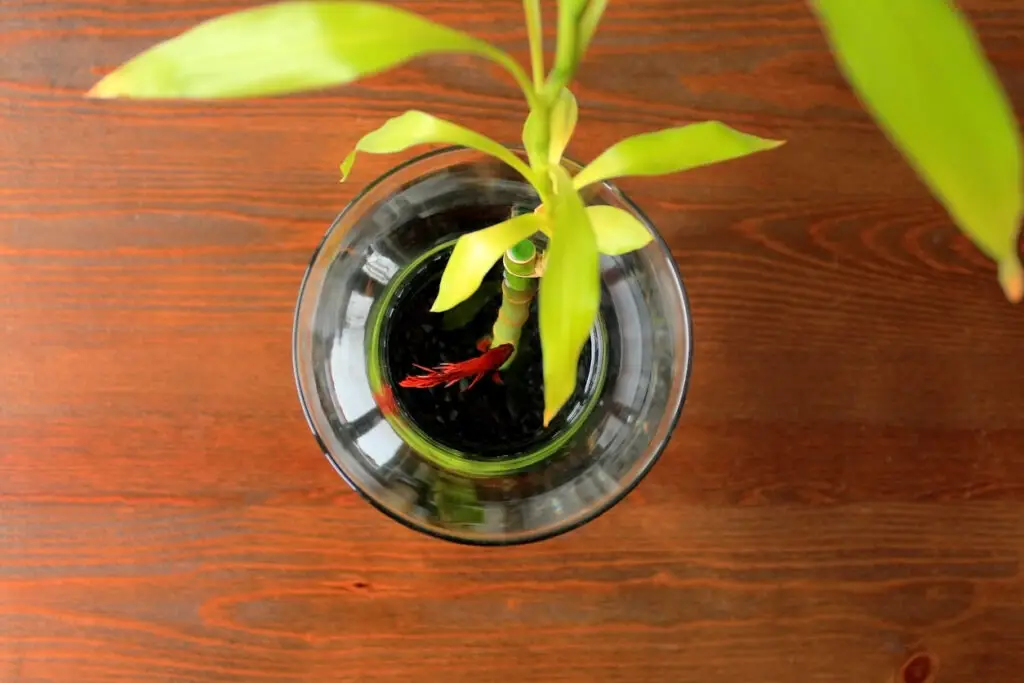Looking for something a little different to grow in your planted fish tank? Consider Lucky Bamboo plants, then. Lucky Bamboo is great for your aquarium, and is easy to grow.
The colorful, braided bamboo plants you often see at florist shops do well in freshwater aquariums and are safe for invertebrates, fish, freshwater eels, and other critters.
And they certainly add some unique “flavor” to the tank with their distinct and unusual looks.
If you’re an aquarist interested in considering this gorgeous aquatic plant for your fish tank, read on.
Quick Overview Facts on Lucky Bamboo
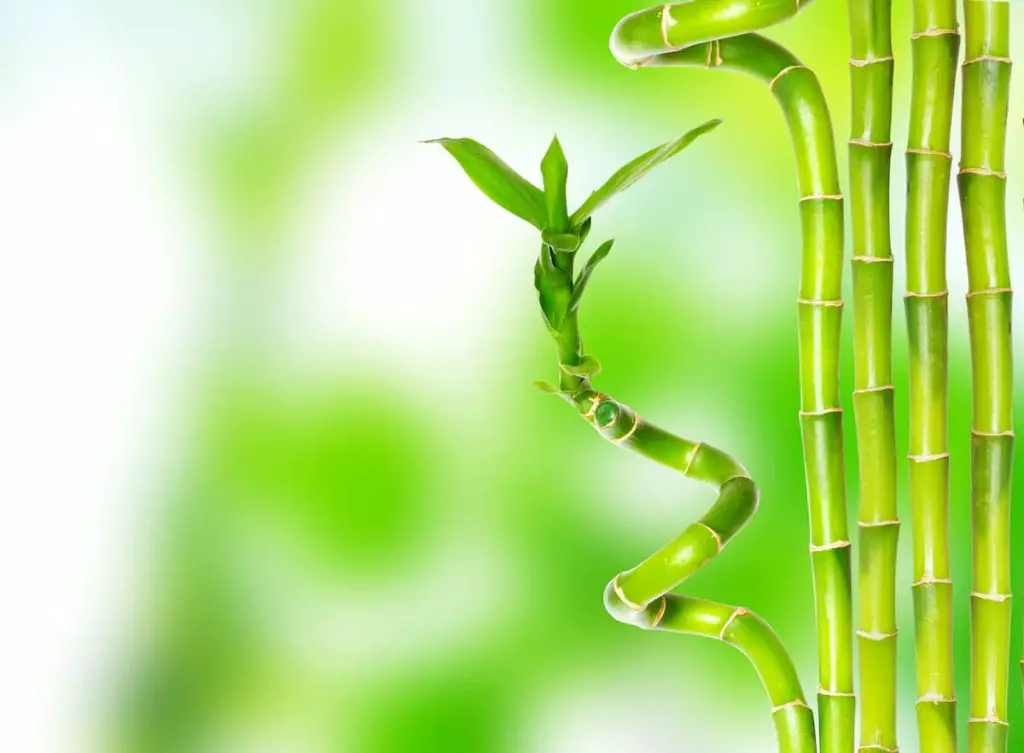
Lucky Bamboo is a completely different species of plant from what people commonly think of as being bamboo. While Lucky Bamboo and real bamboo do share some physical characteristics, they are not actually related. Lucky bamboo is a type of water lily and bamboo is a type of grass.
True bamboo is a type of grass, which means bamboo is a close relative of food plants like rice, wheat, and barley. There are a thousand variations and species of bamboo.
Due to how this plant is able to grow quickly and thrive in a variety of environments, a number of bamboo plants have been classified as invasive species, the bamboo leaves taking over!
Lucky Bamboo comes from its natural habitat in Central Africa. This plant is a flowering lily that loves to be in environments with humidity. It’s easiest to find the country of Cameroon.
This plant likes to grow under the canopy of trees in tropical forests and has evolved to be able to survive seasonal floods and dry spells. It is a plant that is tough and hard to kill by accident.
The inclusion of Lucky Bamboo in aquascapes is actually quite controversial among aquarium owners. If you decide to use this plant it is easy to take care of because it is so hardy.
| Scientific Name: | Dracaena sanderiana |
| Genus: | Dracaena |
| Other Names: | Sander’s dracaena, ribbon dracaena, curly bamboo, Chinese water bamboo, Goddess of Mercy’s plant, Belgian evergreen, ribbon plant |
| Lighting Needs: | Ideally bright light – can tolerate some shade or mid-brightness |
| Growth Rate: | Moderate |
| Temperature Requirements: | 65 to 90 F |
| pH Level: | 6.0 to 6.5 |
| Water hardness: | 0 to 8 dGH |
| Care Level: | Easy to intermediate |
| Minimum Tank Size: | 5 gallons |
| Maximum Plant Size: | up to 4 feet tall |
About Lucky Bamboo
Lucky bamboo is not just popular in aquariums but has recently also become a popular choice for a houseplant, thanks to the beautiful lucky bamboo leaves and uniquely attractive stalks.
This plant does not require soil, all it needs is a few inches of water and it will thrive and grow.
Myths About Lucky Bamboo
There are several myths concerning Lucky Bamboo. These myths have contributed to the controversy in fishkeeping circles about if people should use it in their aquariums.
Lucky Bamboo Isn’t Dangerous for Fish
One of the most common myths is that Lucky Bamboo is dangerous to goldfish, betta fish, and others. The reason this myth is so pervasive is that true bamboo is dangerous to fish.
As lucky bamboo is a completely different species, it will not harm your fish. If anything, planting lucky bamboo can help your fish because it will reduce the nitrate levels in the tank.
You Don’t Need to Keep it in the Filter for Optimal Growth
Oddly, some folks have spread the rumor that in order to keep lucky bamboo happy, you have to place it in the filter. This simply isn’t true. The plant will do all right in other places as well within the aquarium.
The trick is that it needs proper aeration. Now, admittedly, it is easier for the plant to receive this high aeration within the filtration system, but they thrive in all sorts of settings, as long as they’re properly maintained and cared for.
Leaves Above or Below the Water – There is No Right or Wrong
Some folks swear that the leaves of the lucky bamboo have to be above the water for the plant to thrive. Others swear the opposite.
Since both are correct – and therefore also both wrong – there is no right or wrong approach to this. The key is caring properly for the plant. That’s it. Keep the plant pruned, well-fed, and aerated, and the plant will thrive.
Uses and Benefits of Lucky Bamboo in a Fish Aquarium

Fishkeepers who love Lucky Bamboo do so because of how it is unique and can serve multiple purposes.
One of the unique characteristics of Lucky Bamboo is that it is thick, sturdy, and tall. These combined qualities mean that, unlike most aquarium plants, they won’t move with the water flow.
This quality of lucky bamboo means that it is stationary and can be used to create paths for your fish to swim through.
For those interested in creating a unique look for your aquarium, Lucky Bamboo is a popular choice. Some will use this plant as a background for part of a larger decoration theme.
The plant can be purely ornamental or be used to provide a hiding place for your fish. Shy fish and those that enjoy their privacy will be happy to take advantage of live plants.
Lucky Bamboo can be used to improve your aquarium’s conditions. There are common myths that Lucky Bamboo is bad for a tank. Some think that it will rot and poison the tank. In actuality, lucky bamboo pulls nitrates from the water and will use them to grow.
All aquarium fish cause ammonia and nitrites to build up in their tank as they go about their fishy lives. If these toxins build up in the tank then the fish will die.
Lucky Bamboo collects nutrients from fish waste via their roots. The result is that your plants will grow faster and your tank will become a healthier home for your fish.
One of the most difficult tasks for a fishkeeper is maintaining high-quality water.
In addition, the plants will also increase the oxygen levels in the water. This is a great help because of how difficult balancing water levels can be.
Not only can Lucky bamboo be arranged in such a way that it looks great, but it can also be used as a place for shyer fish to hide. The roots of this plant grow in such a way that they can be used for hiding for small fish, as well as provide a snack for your fish.
It is important to remember that your plants also need to be taken care of. If Lucky Bamboo doesn’t receive what it needs to be healthy, then it will get sick, die, and start to decompose.
The decomposition of plants is enough to make sensitive fish sick and makes your tank look dirty.
Tank Requirements for Lucky Bamboo
Lucky bamboo is fairly easy to care for, but there are some requirements to keep it happy.
Lucky bamboo is freshwater and not suitable for salt or brackish water aquariums. The target pH level for this plant is between 6.0-6.5, however, it can survive in a wider range of pH.
Your tank needs to be big enough that at least two-three inches of the plant’s root system is submerged below the waterline in your planted aquarium.
One suggested way to use the plant is to play four inches deep into the substrate.
To make sure Lucky Bamboo gets the nutrition it needs, it is best to use an aquarium-safe liquid fertilizer or to place fertilizer tabs into the substrate it will be growing in.
Basic Care Guide for Lucky Bamboo
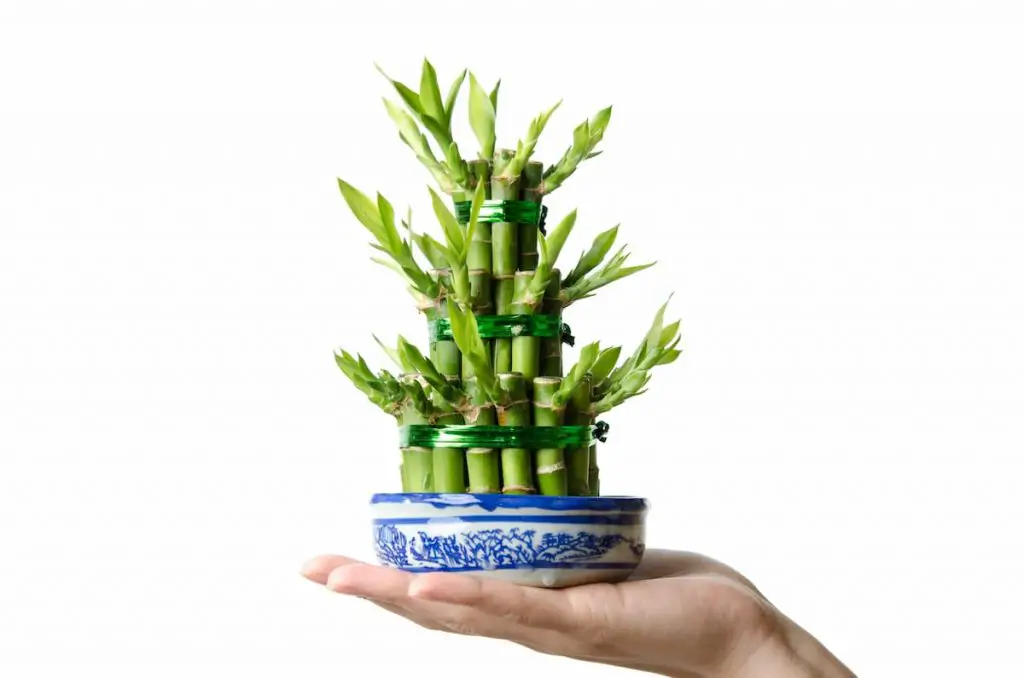
Lucky bamboo is known for being a plant that is relatively easy to grow. This means it is a great choice for fish keepers of all experience levels.
It is really easy to decorate your tank using this plant. Some fishkeepers like to use it as a background while other fish keepers prefer to build a small forest in their tank that their fish can take advantage of.
It needs to have a steady supply of carbon and other nutrients. Many fishkeepers use plant fertilizer to help it get everything it needs.
It is important to follow all the instructions when using plant fertilizers like Flourish Excel. Using too little or too much will result in your plant either being starved for nutrition or possibly even dying from being oversaturated.
Common Problems with Lucky Bamboo
Without the right conditions, Lucky Bamboo can struggle to grow and develop health issues. The majority of this plant’s health issues will show in the leaves before moving to the stalk.
If you notice brown spots, yellow leaves, or stunted growth then you have a problem.
When trying to determine what is wrong, the first place is to start by testing the water levels. If the nitrite or ammonia is present and too high, it could damage the plant.
It is important to check the light level and make sure that the light isn’t too strong or that direct sunlight is shining into the tank.
Checking the oxygen level of the tank water can tell you if the water is sufficiently aerated.
How to Plant Lucky Bamboo
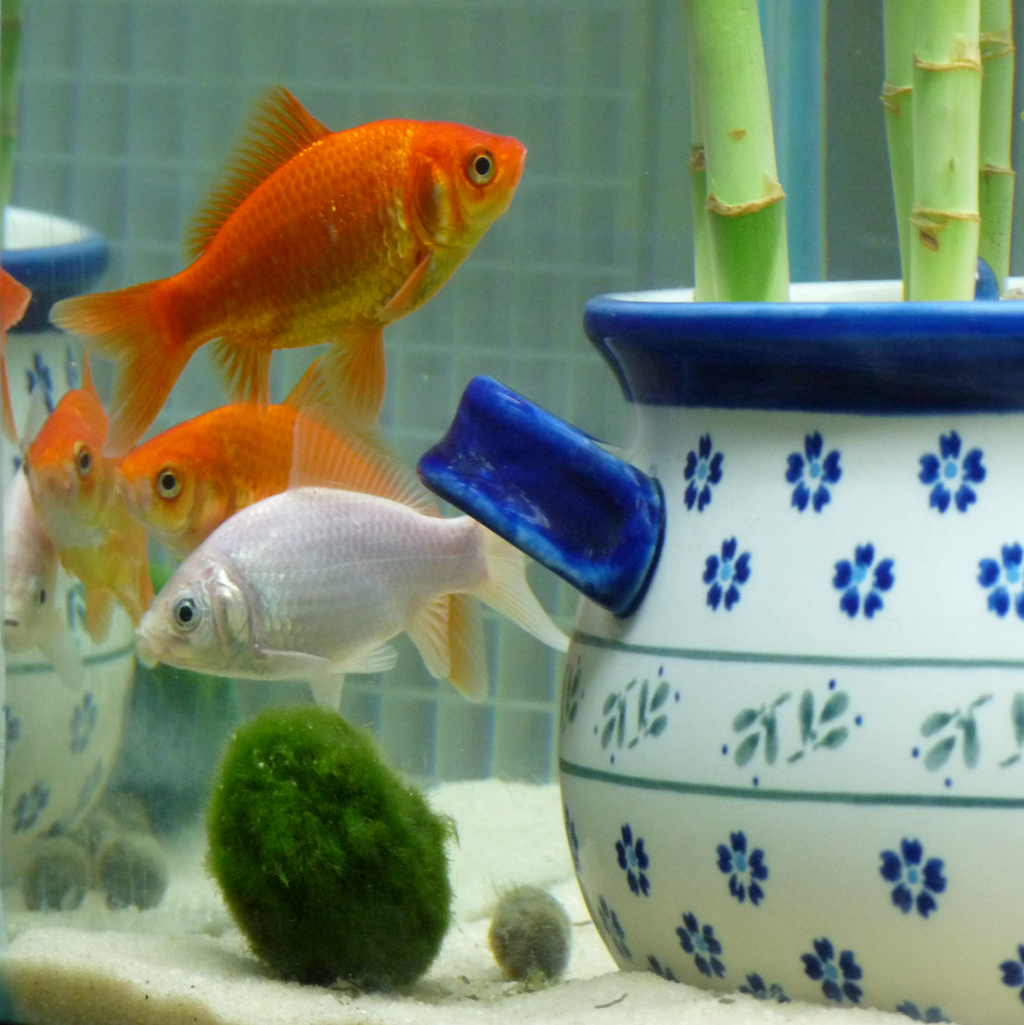
For Lucky Bamboo to thrive in a tank, there are several factors to take into consideration.
The four most important considerations are adequate planting, sufficient nutrition, aeration, and light exposure.
Lucky Bamboo needs enough carbon dioxide to grow. Some of this can be supplied by being in the same tank with fish, but it is not always enough. Using the right kind of aquarium fertilizer can aid the plant in growing.
This plant should be planted in at least four more inches worth of substrate. This will help the plant stay uprate, protect vulnerable roots from hungry fish, and be able to better absorb any fish waste at the bottom of your tank.
In addition, the deeper it is planted the less likely it is for the roots to grow out of the substrate.
For plants to live they need oxygen to trigger photosynthesis, being submerged in water doesn’t change this need for the plant.
Part of making sure the water is properly aerated is by making sure the water is completely changed at least once a week. Another way to ensure proper oxygen levels is by using air stones and filters built like a waterfall.
Lucky Bamboo should have constant exposure to sunlight. Constant light could damage this plant or even kill it. It needs limited direct sunlight.
How to Trim Lucky Bamboo
Lucky Bamboo should be trimmed as often as you see fit, using the right tools. It does not grow horizontal so you only have to worry about it growing too tall.
As long as the plant isn’t threatening to spill out of your tank or looks bad, most people simply let the plant grow.
Most people only trim it once or twice a year. Unwanted growths should be cut just above one of its nodes.
How to Propagate Lucky Bamboo
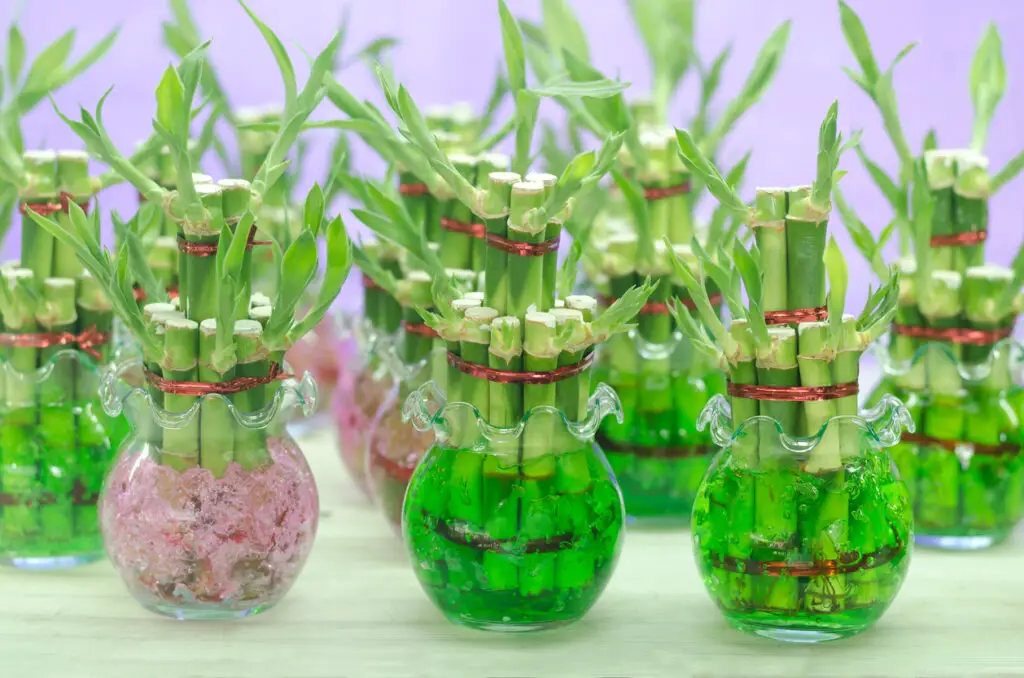
During the normal lifetime of the plant, it is produced offshoots. These appear at nodes on the plant and can grow about half the width of the primary stalk.
If you desire to have more plants in your tank you can always use these offshoots to create new plants.
If you decide to use these offshoots, it is first important to make sure your plant is healthy. It is important to let the offshoot start to develop multiple leaf joints so it is capable of surviving.
The longer the offshoot is allowed to develop the better chance it has of surviving on its own.
This plant doesn’t tolerate dry roots so allowing enough time for length means it can be planted easier.
When the shoot is long enough, cut away any leaves needed so you can see the node on the plant. It’s best to use sharp scissors when you cut the node so that it will be a clean cut.
It should be sawed off and jagged edges will make it harder for the plant to survive.
We hope you enjoyed our guide on growing lucky bamboo in your aquarium!
